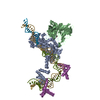[English] 日本語
 Yorodumi
Yorodumi- PDB-6xny: Structure of RAG1 (R848M/E649V)-RAG2-DNA Strand Transfer Complex ... -
+ Open data
Open data
- Basic information
Basic information
| Entry | Database: PDB / ID: 6xny | ||||||
|---|---|---|---|---|---|---|---|
| Title | Structure of RAG1 (R848M/E649V)-RAG2-DNA Strand Transfer Complex (Paired-Form) | ||||||
 Components Components |
| ||||||
 Keywords Keywords | RECOMBINATION / DNA Transposase | ||||||
| Function / homology |  Function and homology information Function and homology informationmature B cell differentiation involved in immune response / B cell homeostatic proliferation / negative regulation of T cell differentiation in thymus / DN2 thymocyte differentiation / pre-B cell allelic exclusion / positive regulation of organ growth / regulation of behavioral fear response / V(D)J recombination / negative regulation of T cell apoptotic process / phosphatidylinositol-3,4-bisphosphate binding ...mature B cell differentiation involved in immune response / B cell homeostatic proliferation / negative regulation of T cell differentiation in thymus / DN2 thymocyte differentiation / pre-B cell allelic exclusion / positive regulation of organ growth / regulation of behavioral fear response / V(D)J recombination / negative regulation of T cell apoptotic process / phosphatidylinositol-3,4-bisphosphate binding / negative regulation of thymocyte apoptotic process / histone H3K4me3 reader activity / phosphatidylinositol-3,5-bisphosphate binding / regulation of T cell differentiation / organ growth / positive regulation of T cell differentiation / T cell lineage commitment / B cell lineage commitment / phosphatidylinositol-3,4,5-trisphosphate binding / T cell homeostasis / T cell differentiation / protein autoubiquitination / phosphatidylinositol-4,5-bisphosphate binding / phosphatidylinositol binding / thymus development / B cell differentiation / visual learning / RING-type E3 ubiquitin transferase / ubiquitin-protein transferase activity / ubiquitin protein ligase activity / T cell differentiation in thymus / chromatin organization / endonuclease activity / histone binding / DNA recombination / sequence-specific DNA binding / adaptive immune response / Hydrolases; Acting on ester bonds / defense response to bacterium / chromatin binding / protein homodimerization activity / DNA binding / zinc ion binding / nucleoplasm / metal ion binding / identical protein binding / nucleus Similarity search - Function | ||||||
| Biological species |  | ||||||
| Method | ELECTRON MICROSCOPY / single particle reconstruction / cryo EM / Resolution: 2.9 Å | ||||||
 Authors Authors | Zhang, Y. / Corbett, E. / Wu, S. / Schatz, D.G. | ||||||
| Funding support |  United States, 1items United States, 1items
| ||||||
 Citation Citation |  Journal: EMBO J / Year: 2020 Journal: EMBO J / Year: 2020Title: Structural basis for the activation and suppression of transposition during evolution of the RAG recombinase. Authors: Yuhang Zhang / Elizabeth Corbett / Shenping Wu / David G Schatz /  Abstract: Jawed vertebrate adaptive immunity relies on the RAG1/RAG2 (RAG) recombinase, a domesticated transposase, for assembly of antigen receptor genes. Using an integration-activated form of RAG1 with ...Jawed vertebrate adaptive immunity relies on the RAG1/RAG2 (RAG) recombinase, a domesticated transposase, for assembly of antigen receptor genes. Using an integration-activated form of RAG1 with methionine at residue 848 and cryo-electron microscopy, we determined structures that capture RAG engaged with transposon ends and U-shaped target DNA prior to integration (the target capture complex) and two forms of the RAG strand transfer complex that differ based on whether target site DNA is annealed or dynamic. Target site DNA base unstacking, flipping, and melting by RAG1 methionine 848 explain how this residue activates transposition, how RAG can stabilize sharp bends in target DNA, and why replacement of residue 848 by arginine during RAG domestication led to suppression of transposition activity. RAG2 extends a jawed vertebrate-specific loop to interact with target site DNA, and functional assays demonstrate that this loop represents another evolutionary adaptation acquired during RAG domestication to inhibit transposition. Our findings identify mechanistic principles of the final step in cut-and-paste transposition and the molecular and structural logic underlying the transformation of RAG from transposase to recombinase. | ||||||
| History |
|
- Structure visualization
Structure visualization
| Movie |
 Movie viewer Movie viewer |
|---|---|
| Structure viewer | Molecule:  Molmil Molmil Jmol/JSmol Jmol/JSmol |
- Downloads & links
Downloads & links
- Download
Download
| PDBx/mmCIF format |  6xny.cif.gz 6xny.cif.gz | 394.7 KB | Display |  PDBx/mmCIF format PDBx/mmCIF format |
|---|---|---|---|---|
| PDB format |  pdb6xny.ent.gz pdb6xny.ent.gz | 301 KB | Display |  PDB format PDB format |
| PDBx/mmJSON format |  6xny.json.gz 6xny.json.gz | Tree view |  PDBx/mmJSON format PDBx/mmJSON format | |
| Others |  Other downloads Other downloads |
-Validation report
| Summary document |  6xny_validation.pdf.gz 6xny_validation.pdf.gz | 1 MB | Display |  wwPDB validaton report wwPDB validaton report |
|---|---|---|---|---|
| Full document |  6xny_full_validation.pdf.gz 6xny_full_validation.pdf.gz | 1 MB | Display | |
| Data in XML |  6xny_validation.xml.gz 6xny_validation.xml.gz | 56.8 KB | Display | |
| Data in CIF |  6xny_validation.cif.gz 6xny_validation.cif.gz | 86.1 KB | Display | |
| Arichive directory |  https://data.pdbj.org/pub/pdb/validation_reports/xn/6xny https://data.pdbj.org/pub/pdb/validation_reports/xn/6xny ftp://data.pdbj.org/pub/pdb/validation_reports/xn/6xny ftp://data.pdbj.org/pub/pdb/validation_reports/xn/6xny | HTTPS FTP |
-Related structure data
| Related structure data |  22273MC  6xnxC  6xnzC M: map data used to model this data C: citing same article ( |
|---|---|
| Similar structure data |
- Links
Links
- Assembly
Assembly
| Deposited unit | 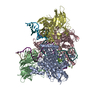
|
|---|---|
| 1 |
|
- Components
Components
-V(D)J recombination-activating protein ... , 2 types, 4 molecules ACBD
| #1: Protein | Mass: 85750.781 Da / Num. of mol.: 2 / Mutation: R848M, E649V Source method: isolated from a genetically manipulated source Source: (gene. exp.)   Homo sapiens (human) Homo sapiens (human)References: UniProt: P15919, Hydrolases; Acting on ester bonds, RING-type E3 ubiquitin transferase #2: Protein | Mass: 40416.984 Da / Num. of mol.: 2 Source method: isolated from a genetically manipulated source Source: (gene. exp.)   Homo sapiens (human) / References: UniProt: P21784 Homo sapiens (human) / References: UniProt: P21784 |
|---|
-DNA chain , 5 types, 6 molecules xyIJLM
| #3: DNA chain | Mass: 16901.791 Da / Num. of mol.: 1 / Source method: obtained synthetically / Source: (synth.)  | ||||
|---|---|---|---|---|---|
| #4: DNA chain | Mass: 20322.986 Da / Num. of mol.: 1 / Source method: obtained synthetically / Source: (synth.)  | ||||
| #5: DNA chain | Mass: 4923.204 Da / Num. of mol.: 2 / Source method: obtained synthetically / Source: (synth.)  #6: DNA chain | | Mass: 13877.906 Da / Num. of mol.: 1 / Source method: obtained synthetically / Source: (synth.)  #7: DNA chain | | Mass: 10461.758 Da / Num. of mol.: 1 / Source method: obtained synthetically / Source: (synth.)  |
-Non-polymers , 2 types, 6 molecules 


| #8: Chemical | ChemComp-MG / #9: Chemical | |
|---|
-Details
| Has ligand of interest | Y |
|---|
-Experimental details
-Experiment
| Experiment | Method: ELECTRON MICROSCOPY |
|---|---|
| EM experiment | Aggregation state: PARTICLE / 3D reconstruction method: single particle reconstruction |
- Sample preparation
Sample preparation
| Component |
| ||||||||||||||||||||||||
|---|---|---|---|---|---|---|---|---|---|---|---|---|---|---|---|---|---|---|---|---|---|---|---|---|---|
| Molecular weight | Units: KILODALTONS/NANOMETER / Experimental value: NO | ||||||||||||||||||||||||
| Source (natural) |
| ||||||||||||||||||||||||
| Source (recombinant) |
| ||||||||||||||||||||||||
| Buffer solution | pH: 7.6 Details: 20 mM HEPES pH7.6, 0.5 mM TCEP, 5 mM MgCl2 and 150 mM KCl | ||||||||||||||||||||||||
| Specimen | Conc.: 0.4 mg/ml / Embedding applied: NO / Shadowing applied: NO / Staining applied: NO / Vitrification applied: YES | ||||||||||||||||||||||||
| Specimen support | Grid material: COPPER / Grid mesh size: 400 divisions/in. / Grid type: C-flat-2/1 | ||||||||||||||||||||||||
| Vitrification | Instrument: FEI VITROBOT MARK IV / Cryogen name: ETHANE / Humidity: 100 % / Chamber temperature: 283 K |
- Electron microscopy imaging
Electron microscopy imaging
| Experimental equipment |  Model: Titan Krios / Image courtesy: FEI Company |
|---|---|
| Microscopy | Model: FEI TITAN KRIOS |
| Electron gun | Electron source:  FIELD EMISSION GUN / Accelerating voltage: 300 kV / Illumination mode: FLOOD BEAM FIELD EMISSION GUN / Accelerating voltage: 300 kV / Illumination mode: FLOOD BEAM |
| Electron lens | Mode: BRIGHT FIELD / Nominal magnification: 130000 X / Nominal defocus max: 2300 nm / Nominal defocus min: 800 nm / Cs: 2.7 mm / C2 aperture diameter: 50 µm |
| Specimen holder | Cryogen: NITROGEN / Specimen holder model: FEI TITAN KRIOS AUTOGRID HOLDER |
| Image recording | Average exposure time: 11 sec. / Electron dose: 72.8 e/Å2 / Detector mode: SUPER-RESOLUTION / Film or detector model: GATAN K2 SUMMIT (4k x 4k) / Num. of real images: 3527 |
- Processing
Processing
| EM software |
| ||||||||||||||||||||||||||||||||||||
|---|---|---|---|---|---|---|---|---|---|---|---|---|---|---|---|---|---|---|---|---|---|---|---|---|---|---|---|---|---|---|---|---|---|---|---|---|---|
| CTF correction | Type: PHASE FLIPPING AND AMPLITUDE CORRECTION | ||||||||||||||||||||||||||||||||||||
| Particle selection | Num. of particles selected: 636773 | ||||||||||||||||||||||||||||||||||||
| Symmetry | Point symmetry: C1 (asymmetric) | ||||||||||||||||||||||||||||||||||||
| 3D reconstruction | Resolution: 2.9 Å / Resolution method: FSC 0.143 CUT-OFF / Num. of particles: 44428 / Num. of class averages: 3 / Symmetry type: POINT | ||||||||||||||||||||||||||||||||||||
| Atomic model building | Protocol: RIGID BODY FIT / Space: REAL | ||||||||||||||||||||||||||||||||||||
| Atomic model building | PDB-ID: 5ZDZ Accession code: 5ZDZ / Source name: PDB / Type: experimental model |
 Movie
Movie Controller
Controller




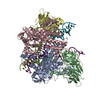
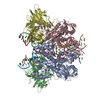


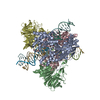



 PDBj
PDBj











































